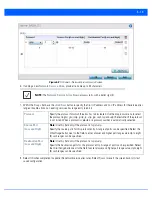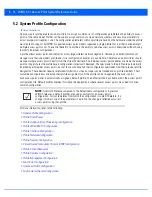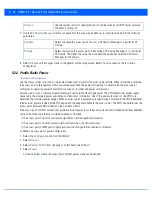
5 - 14 WiNG 5.7.1 Access Point System Reference Guide
5.2 System Profile Configuration
An access point profile enables an administrator to assign a common set of configuration parameters and policies to access
points of the same model. Profiles can be used to assign common or unique network, wireless and security parameters to
across a large, multi segment, site. The configuration parameters within a profile are based on the hardware model the profile
was created to support. All WING 5 supported access point models supported a single profile that is either shared amongst
multiple access point or not. The central benefit of a profile is the ability to update access points collectively without having
to modify individual configurations.
A profile allows access point administration across large wireless network segments. However, an administrator cannot
manage more than one model’s profile and its set configuration policies at any one time. Therefore, an administrator should
manage multiple access points directly from the Virtual Controller AP. As individual access point updates are made, the access
point no longer shares the profile based configuration it previously deployed. Changes made to the profile are automatically
inherited by all member access points, but not those who have had their configuration overridden from their previous profile
designation. These devices require careful administration, as they no longer can be tracked and as profile members. Their
customized configurations overwrite their profile assignments until the profile can be re-applied to the access point.
Each access point model is automatically assigned a default profile. The default profile is available within the access point’s
configuration file. Default profiles are ideal for single site deployments where several access points may need to share a
common configuration.
For more information, refer to the following:
•
•
•
Profile Adoption (Auto Provisioning) Configuration
•
Profile Wired 802.1X Configuration
•
Profile Interface Configuration
•
•
Profile Security Configuration
•
Virtual Router Redundancy Protocol (VRRP) Configuration
•
•
Profile Services Configuration
•
Profile Management Configuration
•
•
Advanced Profile Configuration
•
Environmental Sensor Configuration
NOTE:
A central difference compared to the default-radio configurations in previous
WiNG 5 releases is default profiles are used as pointers for an access point’s
configuration, not just templates from which the configuration is copied. Therefore, if a
change is made in one of the parameters in a profile, the change is reflected across all
access points using that profile.
Summary of Contents for WiNG 5.7.1
Page 1: ...WiNG 5 7 1 ACCESS POINT SYSTEM REFERENCE GUIDE ...
Page 2: ......
Page 3: ...WING 5 7 1 ACCESS POINT SYSTEM REFERENCE GUIDE MN001977A01 Revision A April 2015 ...
Page 4: ...ii WiNG 5 7 1 Access Point System Reference Guide ...
Page 24: ...1 4 WiNG 5 7 1 Access Point System Reference Guide ...
Page 36: ...2 12 WiNG 5 7 1 Access Point System Reference Guide ...
Page 72: ...3 36 WiNG 5 7 1 Access Point System Reference Guide ...
Page 470: ...5 386 WiNG 5 7 1 Access Point System Reference Guide ...
Page 472: ...6 2 WiNG 5 7 1 Access Point System Reference Guide Figure 6 1 Configuration Wireless menu ...
Page 624: ...7 46 WiNG 5 7 1 Access Point System Reference Guide ...
Page 724: ...9 56 WiNG 5 7 1 Access Point System Reference Guide ...
Page 783: ...12 35 Figure 12 46 Device Summary screen 4 Click File Management ...
Page 816: ...12 68 WiNG 5 7 1 Access Point System Reference Guide ...
Page 1006: ...13 190 WiNG 5 7 1 Access Point System Reference Guide ...
Page 1026: ...14 20 WiNG 5 7 1 Access Point System Reference Guide ...
Page 1028: ...A 2 WiNG 5 7 1 Access Point System Reference Guide ...
Page 1089: ......
Page 1090: ...MN001977A01 Revision A April 2015 ...
















































